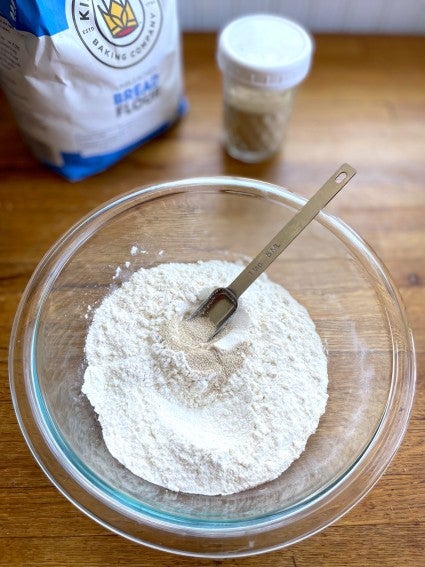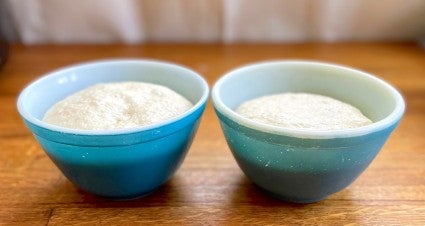Things bakers know: Instant yeast is superior to active dry. Here’s why.
Speed, price, ease of use — and results.


I haven’t used active dry yeast in my homemade bread, rolls, and pizza for nearly three decades. Not a single granule. And it’s not because I’m a sourdough purist.
So, what’s the deal? How do I get my dinner rolls to rise?
Instant yeast: the only type of yeast I’ve used in my kitchen since King Arthur introduced it to home bakers over 25 years ago. Specifically, I use SAF Red instant yeast (or SAF Gold for sweet breads). And in all that time (over 1,000 bakes later), I’ve never had a yeast-induced failure — not even the times when I used some 6-year-old SAF I discovered in the bottom of my chest freezer!
And it’s not just me who prefers instant yeast – it’s been a staple in both our King Arthur Test Kitchen and King Arthur Bakery for over 20 years.
Can you bake great bread with active dry, rapid, fresh compressed, or other kinds of yeast? Of course, and people did, for decades. But times change. Here’s why I always have instant yeast in my freezer — and why you should, too.

Mix instant yeast with your flour and other dough ingredients; there’s no need to dissolve it in warm water or another liquid first, as you might with active dry or other yeasts that need to be proofed (i.e., dissolved to ensure they’re alive). That’s one less step to take; 10 minutes proofing time saved.
Plus, instead of having to rip open the typical tiny pre-measured packet of active dry yeast — which might not even contain the amount you want to use — you simply have to spoon instant yeast from its 1-pound sack (or the container you’ve stashed it in).

Not only does it skip the proofing/dissolving step, instant yeast simply ramps up more quickly than active dry. Dough made with instant yeast and shaped into a loaf will rise to its optimal height significantly more quickly than a shaped loaf made with active dry yeast.
In fact, instant yeast is equivalent to rapid-acting yeast in initial speed, starting to raise dough almost immediately. But instant yeast will keep working long beyond the quick arc of rapid yeast, allowing you to refrigerate your instant-yeast dough for days and still get a good, strong rise at the end.
A pound of instant yeast is ridiculously inexpensive: you’ll only use about 11 cents of instant yeast (the equivalent of a standard 1/4-ounce packet) in each loaf you bake. Compare that to the $1.66 per one-loaf packet Amazon’s currently getting for active dry yeast; or even the 90¢ per packet charged at a typical supermarket. (Want to increase your savings even more? See How to bake bread using less yeast.)
Substitute instant yeast 1:1 by weight or volume for any active dry yeast called for in your recipe. If your recipe calls for a packet of yeast (7g, a slightly heaped 2 teaspoons), use the same amount of instant. Simply add it to your bowl along with the flour and other dry ingredients; no need to dissolve it first. See? Quick and easy.
You don’t know how you’ll ever use up a pound of yeast? Stored in an airtight container in the back or bottom of the freezer, it can last for years. But honestly, you’ll love baking with instant yeast so much it won’t be around nearly that long!

SAF instant yeast is used every day in the King Arthur Test Kitchen. It’s certainly my yeast of choice; and I hope from now on it’s yours, too. In case you’re curious, here are a few of my go-to (instant) yeast recipes:
Classic Sandwich Bread — This nostalgic pan loaf is close-grained, nicely sliceable, and perfect for sandwiches and toast.
Golden Pull-Apart Butter Buns — I’m absolutely required to make these soft white rolls for every family holiday dinner and gathering.
Grandma Pizza — Not super-thin, not ultra-thick, this crust is the perfect base for my favorite topping combo: sautéed portobello mushrooms, artichoke hearts, oven-roasted cherry tomatoes, and a mixture of mozzarella and provolone cheeses.
Soft Cinnamon Rolls – The tangzhong method (think Japanese milk bread) keeps these classic pull-apart-and-unravel rolls nice and soft for days.
Tuscan Coffeecake — Loaded with dried fruit and toasted walnuts, this rich, dense loaf features an inspired sugar-vanilla crackly glaze.
Want to know more? For a complete comparison of instant vs. active dry vs. rapid yeast, see Which yeast to use?
Cover photo and food styling by Kristin Teig.



December 21, 2022 at 2:24pm
In reply to I have a really basic… by Newbie SAF user (not verified)
Hi there! Yes, it is always best to transfer the yeast to an airtight container once it has been opened. The package does not reseal well. Hope this helps!
January 19, 2023 at 2:44pm
In reply to I have a really basic… by Newbie SAF user (not verified)
I put it in a jar and store in the freezer.
November 30, 2022 at 7:56am
I had one question. In a blog post back on September 25, 2015, the article had this: "So, inquiring bakers – inquire no more! You don't need to dissolve active dry yeast in lukewarm water before using it. (Even though it still says you should dissolve it on the back of the yeast packet, if you buy your yeast in packets.)". But here it states: "Mix instant yeast with your flour and other dough ingredients; there’s no need to dissolve it in warm water or another liquid first, as you might with active dry". They seem to contradict each other. So is the information in the 2015 article not valid or contingent on something I'm missing? I'm just trying to reconcile the information in the two articles especially after being told by a baker that much of what we thought we knew about active dry is no longer "as" valid.
December 5, 2022 at 4:40pm
In reply to I had one question. In a… by Shawn (not verified)
Hi Shawn, it's true that active dry yeast has evolved over the years, and these days it's processed and formulated in a way that is more and more similar to instant yeast. Originally active dry yeast was dried at high temperatures, and this created a hard shell of dead yeast cells that needed to be dissolved in lukewarm water before the yeast could activate. Nowadays both types of yeast are processed at lower temperatures, so they activate more easily and faster, although we still find that instant yeast tends to respond faster than active dry. We have found that in general it works fine to add the active dry yeast in with the flour, but there are some circumstances where it still might work better to activate the active dry yeast in lukewarm water. For example, active dry yeast seems a little more temperature sensitive as compared to instant yeast, and when making an overnight starter or dough that calls for "cool" water, it is likely to work better to activate the active dry yeast in a small portion of lukewarm water subtracted from the total liquid amount before adding it to the remaining cool water and the flour. This will ensure that the yeast will dissolve and get going as it should. Instant yeast, on the other hand, should work fine when added in with the flour, even when the water is cool. This article on Desired Dough Temperature covers some of the more nuanced differences between how you handle the two types of yeast, and you may also find our article, All About Yeast, helpful.
March 8, 2023 at 11:21am
In reply to I had one question. In a… by Shawn (not verified)
I guess speed is important - for those of us baking while doing other chores, I'm not sure having the dough rise in 45 minutes versus an hour and ten mins. matters that much. I have recently tried Platinum yeast - not sure if that's considered instant. It supposedly has "dough conditioners"? It was fine too. I guess I'll never understand these things - for instance, some recipes I have call for a slow "cool rise" in the fridge to better develop the dough. So is "slow" never advantageous?
March 10, 2023 at 2:26pm
In reply to I guess speed is important -… by Elizabeth (not verified)
Hi Elizabeth, a slow cold rise is typically to help develop more flavor in the dough. It is very common with no knead bread recipes as well as sourdough.
November 21, 2022 at 3:27pm
I'm ready to convert my standard bread recipes from active-dry to SAF instant yeast. One thing I haven't seen addressed is whether to add the quantity of proofing water to the remaining liquid in the recipe. For example, in my favorite recipe I use 1/2 cup water to proof and, after the yeast proofs, another 1.5 cups of water to combine with the dry ingredients -- so I should use 2 cups of water in the add-to-dry step, right?
November 27, 2022 at 1:30pm
In reply to I'm ready to convert my… by Millie Kaye (not verified)
Hi Millie, yes, you'll want to include the proofing water as part of the dough water when adding the yeast in with the flour.
November 19, 2022 at 3:52pm
I am baking croissants this year. Can I use the instant yeast for my croissant dough?
November 25, 2022 at 1:54pm
In reply to I am baking croissants this… by Helen (not verified)
Hi Helen, yes, our Baker's Croissants recipe calls for instant yeast.
Pagination